G Suite Sync for Microsoft Outlook
Background
If you want to use Outlook on a Windows computer to access your Gmail and Calendar you must use the G Suite Sync for Microsoft Outlook tool. This Google provided tool allows you to synchronize Outlook with your Gmail and Google Calendar ensuring that the same content appears in both the Google web interface and outlook.
Note: A directions for configuring the G Suite Sync for Microsoft Outlook can be downloaded in PDF format and includes instructions for using it to migrate your mail, calendar, and contacts.
Install and setup
- Download the G Suite Sync for Microsoft Outlook (GSSMO).
- Run the googleappssyncsetup.exe.
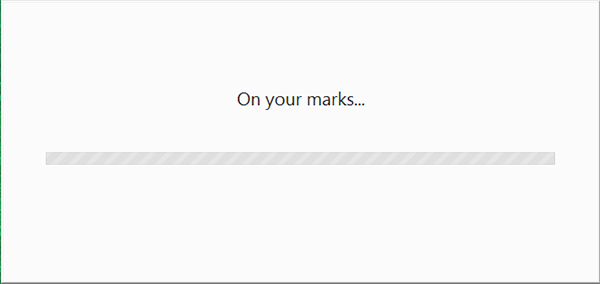
- Note: Symantec Endpoint Protection's Download Insight might display a dialog window with a notice that "Our information on this file is inconclusive." and prompts you if you'd like to Remove this file from my computer, or Allow this file. Click Allow this file.
- You will then be prompted to grant permission for an application exception to be created. Click Ok.
- When prompted enter your Google Apps @ UA account email address, make sure to select the option to Remember me. Click Continue.
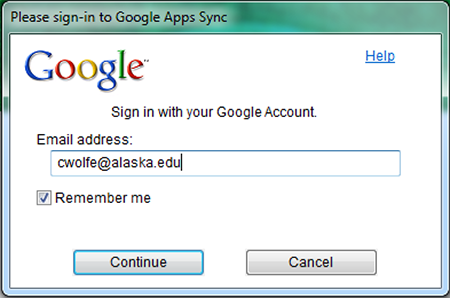
- GSSMO will now launch your preferred web browser to continue sign-in at the Google Apps @ UA sign-in website.
- In your preferred web browser you will see a web page indicating that G Suite Sync for Microsoft Outlook would like to and a list of features. Scroll to the bottom of the site and click Allow.
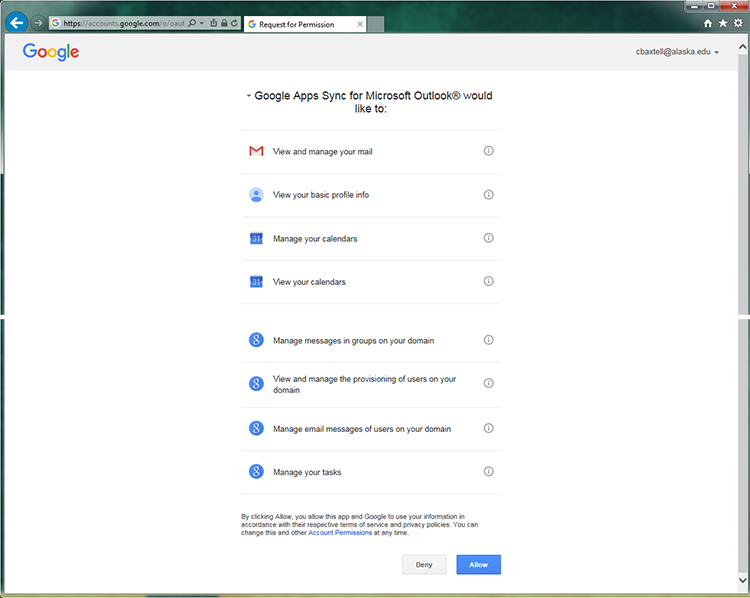
- The website will refresh and display a message indicating that Authorization has been granted successfully. Please switch to your application.
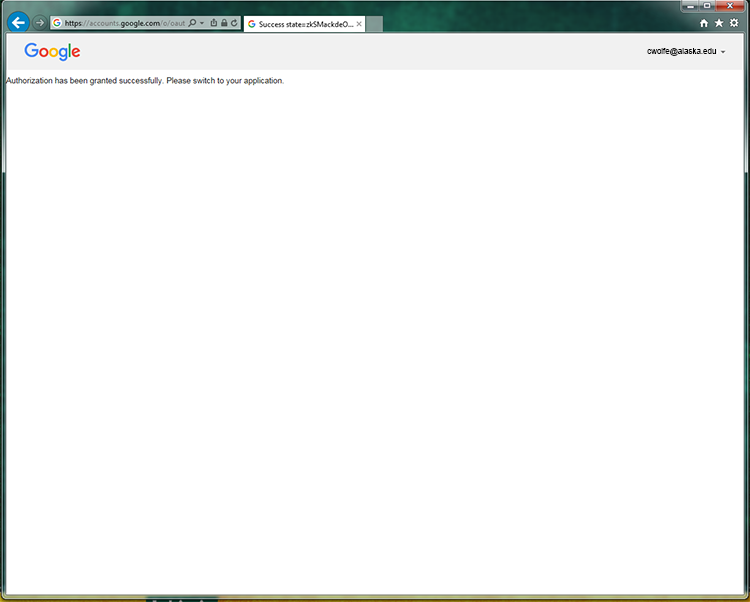
- Close or minimize the browser window and return to GSSMO.
- After sign-in, a dialog appears where you will be prompted to Create a G Suite profile in Microsoft Outlook. Do not select the option to Import data from an existing profile as this will cause duplication of mail in your account. Click Create profile.
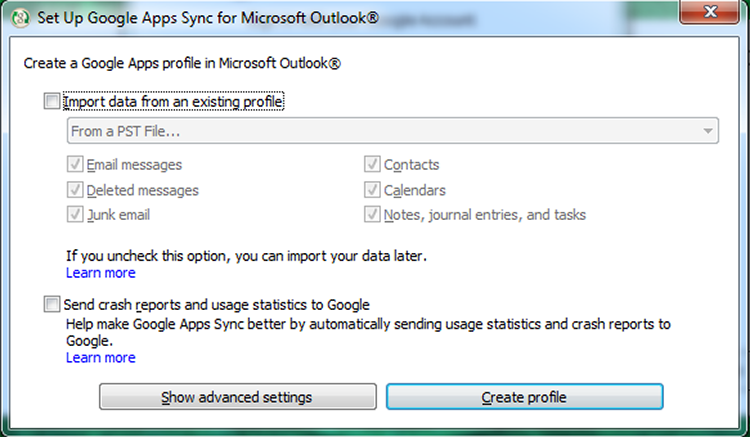
- After the Create profile and setup completes, a dialogue box appears. Click Start Microsoft Outlook to begin.
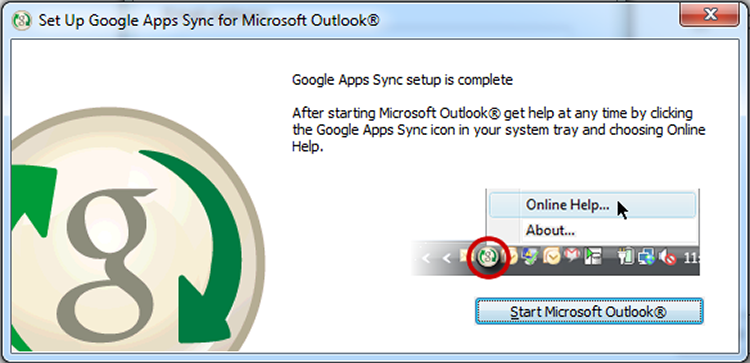
- Microsoft Outlook will open and the GSSMO Synchronization Status dialog window will
appear. Depending upon the amount of data in your Gmail account will determine how
long the sync between Outlook and Gmail will take. You can begin using Outlook to
while the sync completes in the background.
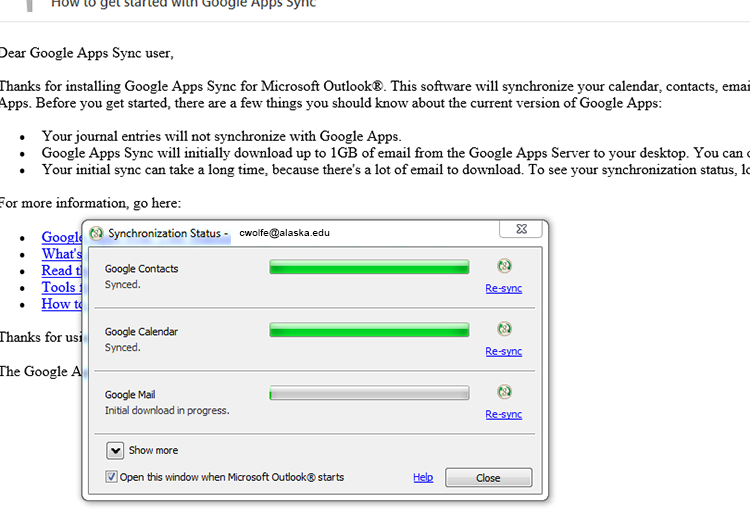
Frequently Asked Questions
- What are the requirements for using GSSMO?
Google currently supports G Suite Sync for Microsoft Outlook on systems which meet the following requirements.
Operating System requirements
- Windows 10 (32 and 64 bit)
- Windows 8 (32 and 64 bit)
- Windows 7 (32 and 64 bit)
- Windows Vista SP 1 (32 and 64 bit)
Microsoft Outlook requirements
- Microsoft Outlook 2016 (32 and 64 bit)
- Microsoft Outlook 2013 (32 and 64 bit)
- Microsoft Outlook 2010 (32 and 64bit)
Note: G Suite Sync for Microsoft Outlook is not supported for Mac because GSSMO requires the legacy Messaging Application Programming Interface (MAPI) (not the newer Exchange Web Services (EWS), or MAPI over HTTP protocols) which is required for G Suite Sync to communicate with Outlook. This GSSMO limitation makes a Mac-compatible version of G Suite Sync infeasible.
- Can I use G Suite for Microsoft Outlook to manage delegated accounts?
If someone has granted you access to their Gmail or Google Calendar account, you can use Google Apps Sync for Microsoft Outlook to manage that person's mail or calendar from outlook.
Please note: It is often simpler to manage delegated accounts using the Google Apps web interface.
- Have the individual grant you access to their Gmail account and/or Google Calendar.
- Go to the Windows Start menu, open All Programs, and choose Google Apps Sync > Add account for delegation.
- From the dialog, choose your Google Apps profile (if more than one Outlook profile is available). Then enter the delegator's primary Email address (do not use an alias).
- If you're accessing the delegator's calendar, configure your calendar notifications to receive their calendar notifications in your own mail inbox.
- Sign in to Google Calendar, click the gear icon in the upper-right and select Gmail settings, and open the Calendars tab.
- Click the Notifications tab next to your manager's calendar (that's been shared with you).
- Check the Email box for each type of notification you want to receive (for new invitations, change invitations, and so on).
- If you've been granted access to thedelegator's calendar but not their email, configure
your Gmail settings to send mail from thedelegator's address, as describe below (if
you have access to thedelegator's email, skip this step).
- Sign in to Google Calendar, click the gear icon in the upper-right and select Gmail settings, and open the Accounts tab.
- Under Send Mail as, click Add another email address you own.
- Enter the delegator's Name and primary Email address, and click Next Step.
- Click Send Verification. This sends an email to the delegator's address with instructions on verifying that you can send from their address (typically the manager just clicks a link in the email to verify).
- You can now begin sending mail and managing calendar invitations on behalf of the delegator.
- Is there a size limit for email messages?Yes. You can send and receive messages up to 25 megabytes (MB) in size including any attachments.
- How do I send an email message larger than 25 MB?
25 MB is a fairly standard limit for most email systems around the world. If you need to transmit a file, or files, that is larger than 25 MB you should consider other options for transferring the file. Some available options are, but not limited to:
- How does Gmail labels differ from folders?
Gmail uses an organization method referred to as labels to manage content. Labels are similar to Outlook categories. Like categories, you can apply one or more labels to a message. With folders a message can only located in one. Like a physical object, it can't be in two places at once.
In Gmail dragging a message to a different label adds that label to the email while removing all other labels, including Inbox. Unfortunately, when you drag from another label to the Inbox, both labels remain on the message. You can also create sub-labels.
If you don't want the message to appear in the Inbox, just click the Archive button when using a web browser to access your Gmail. You can archive messages with or without any labels associated with it.
The Gmail web browser interface has a toolbar has a Move to icon that looks like a folder, and a Labels icon that looks like a label. When you use the Labels tool, Gmail assigns the label you selected leaving other existing labels alone. However, if you use the Move to tool it assigns the label you selected and removes all other labels. This provides the illusion that you've moved the item to a folder.
If you use Outlook with G Suite Sync for Microsoft Outlook while labels will sync to Outlook folders be aware they do not act like traditional Outlook folders. Dragging the message to a different "folder" in Outlook causes Outlook to save a duplicate copy locally of the message. In Gmail the message is not duplicated.
When viewing a label group in Gmail if you "delete" a message you are only removing the selected message(s) from that label group by deleting the associate label. If you "delete" all labels from a message you still have not actually deleted the message. It still resides in a label/group in Gmail called All Mail. To permanently delete a message you must go into this label and delete the message after which Gmail places the item into the Trash. If no other action is done then Gmail automatically deletes messages in the Trash after 30 days.
- What are the recommend "Best Practices" with using Outlook with G Suite Sync for Microsoft
Outlook?
When using Outlook with G Suite Sync for Microsoft Outlook the following are Google's recommended best practices.
Use your new Archived folder
Place messages here that you want to remove from your Inbox but keep around for reference. The Archived folder also contains messages you archive using the Gmail interface, that aren't already in another folder.
Set up mail delegation from Gmail (not Outlook)
You can let an assistant manage your inbox from Outlook by reading, deleting, and sending mail on your behalf. But you set this up in your Gmail web interface, not using the Delegates tab in Outlook's Options dialog (which doesn't work/isn't available with Google Apps Sync).
Use Gmail's Vacation Responder (not Outlook's Out of Office assistant)
You can set up automatic vacation responses to let people who email you know when you're away from your email. But you need to do this in your Gmail web interface, not using Outlook's Out of Office feature (which doesn't work with Google Apps Sync).
Compose HTML mail, not Rich Text
By default, Google Apps Sync sets your preference for composing mail in HTML format, rather than Rich Text. Don't change it back to Rich Text or messages you send won't be readable.
- How often does GSSMO refresh for new data?GSSMO syncs anywhere from a few minutes to a couple of hours depending upon which data is being synced. Google does not publish the specific numbers as they may change due to server load.
Known Issues
- Are nested folders folders supported in Gmail?
Nested folders are converted into nested labels. They will display in Outlook as if they were nested folders.
One notable exception is that Gmail doesn't nest labels under Inbox, Sent Mail, or other system labels. Instead, labels appear as Inbox/folder_name.
- Calendar events are arriving from delegate and not organizer
When using G Suite Sync for Microsoft Outlook the person sharing their calendar must share their primary calendar to the delegate. Invitations the delegate sends from your primary calendar (as apposed to other calenders you own) show you as the organizer in Outlook.
While you can share any of your calenders with a delegate, who can then manage events on that calendar, invitations appear as sent by you for your primary calendar only. For other calendars, invitations form the delegate appear to come directly from the delegate.
- Only some shared calendars sync with Outlook
When using G Suite Sync for Microsoft Outlook only calendars that are "fully shared" are available to sync with Microsoft Outlook. Calendars with free/busy sharing only are not currently able to sync with Outlook.
Individuals that use the Google Web interface will be able to access all calendars shared with them regardless of whether they are shared as free/busy, or all details.
- Calender attachments are not received by attendeesIf you attach a document, contact, or other item to a calendar event in Outlook, you'll see the attachment in your own Outlook calendar, but the other attendees won't see it in theirs. This is because attachments aren't synchronized with other people's Google calendars. Additionally, recipients of the event invitation will receive an email with the name of the event as the subject and the attached item, yet without any RSVP options.
- Deleting calendar invites in Outlook mailDeleting a calendar invitation from Outlook Mail sends the event owner an email saying you've declined the event. This happens even if you've accepted the invitation in your calendar. Instead of deleting invitations from Outlook, we suggest you move them to your Archive folder. Or delete them from your Gmail web interface, which doesn't send a message to the event owner.
- Rich content in calendar eventsYou can add rich content such as links, formatted text, and tables to a calendar description in Outlook. But the formatting doesn't synchronize with other individuals'' calendars so everyone else sees only plain text.
- Tentative or Out of Office statusChoosing Tentative or Out of Office status for a calendar event appears as Busy to other individuals viewing your status. This is because Google Calendar supports only Free or Busy status, not these other alternatives.
- Unable to view, or search, all of my mail in Outlook; however, its visible in Gmail
If you're using the G Suite Sync for Microsoft Outlook (GSSMO) to synchronize data between Outlook and G Suite there are several things that might cause an inability to view, or search, all of your mail within Outlook.
I'm getting sync errors, or synchronization has stopped altogether
Did you select an Unlimited mailbox size in the G Suite Sync? If so, your local PST file might have reached its maximum size allowed by Outlook (20 GB by default), which can cause errors or prevent G Suite Sync from syncing with G Suite at all. You will need to either limit the mailbox size in G Suite Sync (see Set a local mailbox size) or follow the instructions from Microsoft to change the size limit of your PST file and store more than 20 GB locally. Please note that Outlook 2007 is limited to 20 GB, and Outlook 2010, 2013, and 2016 are currently limited to 50 GB for PST files.
I'm having synchronization problems after moving folders by dragging
Reorganizing folders in Outlook via drag-and-drop can cause synchronization issues in G Suite Sync. If you moved folders in this way and now some of your data isn't syncing, create a new profile and data should start syncing properly again.
Outlook isn't showing my older messages (but the Gmail interface is)
This is probably because your local mailbox size (Outlook PST file) isn't large enough to store all your messages locally. G Suite Sync stores the most recent messages locally (up to 1 GB by default). It stores the rest in the cloud, where it's accessible from the Gmail interface. If you want more messages stored locally, you can increase your Mailbox Size Limit. However, this isn't normally recommended as it can have an adverse effect on performance.
- Drafts saved in Outlook don't sync to GmailUnfortunately, G Suite Sync doesn't synchronize email drafts in Gmail or other computers where you use Outlook. Please finish authoring your email using the same client where you started the draft.
- Messages I move out of my Outlook Sent Items folder later reappear there
You can move a message out of your Sent Items folder in Outlook, also removing it from Gmail's Sent Mail label. However, that change doesn't always stick in Gmail. In Gmail, the message may later reappear in your Sent Mail label, then sync back to Outlook's Sent Items folder.
With Gmail, the labeling index is made immediately but, with Outlook, it can take until the next sync to re-index that the message has been moved. It can take up to 24 hours to be synced correctly.
- Can't view .msg or .eml file
If you attach an email message (.msg or .eml file) to a message in Outlook, recipients using Microsoft Exchange will not be able to read the attachment. To avoid this issue, it is best to forward the message itself via Outlook, rather than attach a message as an .msg or .eml file.
- Some of my calendar, contact, notes, or tasks folders aren't syncing
Are they stored somewhere under your top-level Calendar, Contacts, Notes, or Tasks folder in Outlook? If not, they won't sync with Google Apps. When creating new folders in Outlook, be sure to create them under the appropriate Outlook app (Calendar, Contacts, and so on), or their contents will not sync with Google Apps.
In addition, create all notes in your top-level Notes folder in Outlook. Notes placed elsewhere, such is in subfolders, will not sync with Google Docs, Sheets, and Slides.
- Deleting folders in Outlook does not remove the label in Gmail
If you're using Outlook with the G Suite Sync for Microsoft Outlook tool when you delete folders in Outlook they don't really delete in Gmail because of how deleting works in Gmail. If you want to permanently remove these labels you will need to login to Gmail via a web browser and delete them there.
Other related information
Need additional help or have issues
For additional assistance contact the IT Services Technical Support Center via phone at (907) 786-4646, toll-free at (877) 633-3888, or email at uaa.techsupport@alaska.edu.









